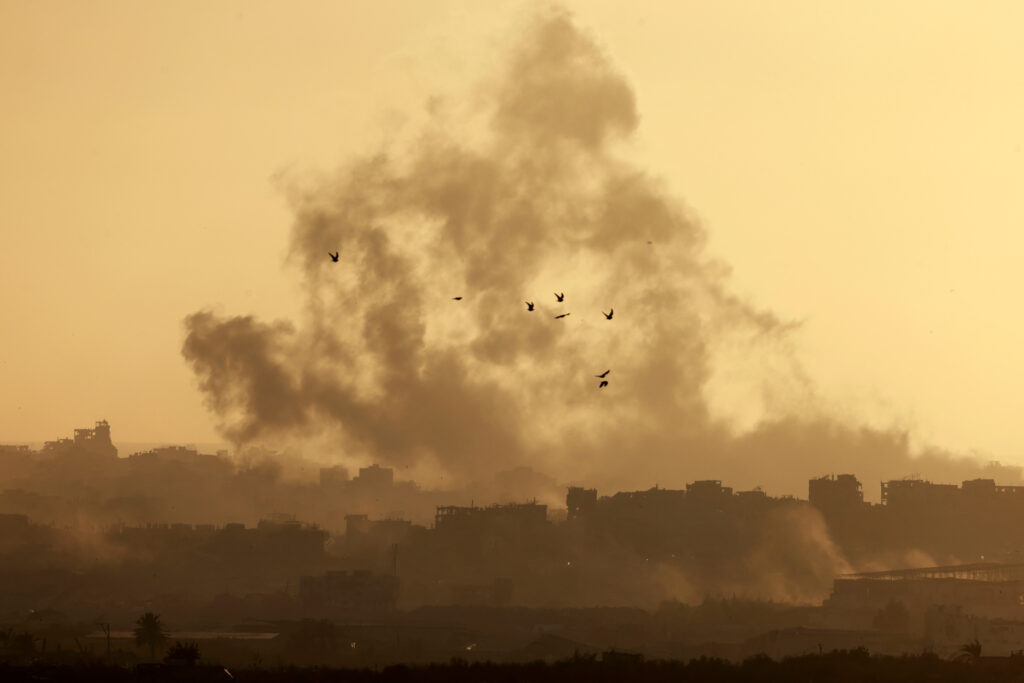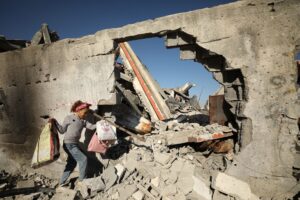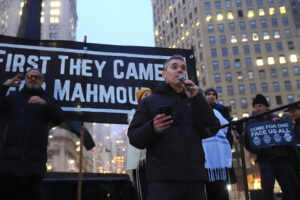A Measure of Things Human

In March 1988, the late Israeli historian Yehuda Elkana, an Auschwitz survivor, published an explosive op-ed in Haaretz on “the need to forget.” He wrote that although he often spoke of the Holocaust to his four children and freely shared his personal recollections of it with them, he had refused to accompany them on visits to Yad Vashem. He had been reluctant to follow the Eichmann trial and he opposed the trial of John Demjanjuk, who had been a guard at the Sobibor death camp and was awaiting sentencing then. Elkana was convinced that the memory of the Holocaust had been co-opted for destructive ends, that it had been maliciously harnessed to fuel hatred and violence against the Palestinian people.
He published his piece when he did—in the midst of the first intifada, not long after footage emerged of Israeli soldiers beating bound and blindfolded Palestinians—perhaps hoping there was still time to reverse course. He explicitly argued that “had the Holocaust not penetrated so deeply into the national consciousness,” the conflict between Jews and Palestinians would not have produced acts of terrorism and abject violence; he even conjectured that the peace process might not have stalled. For Elkana, the time had finally come for the Jewish people to abandon the belief “that the whole world is against us, and that we are the eternal victim.” While the wider world could very well continue to remember the Holocaust, Israelis now had to forget: “Today I see no more important political and educational task for the leaders of this nation than to take their stand on the side of life, to dedicate themselves to creating our future, and not to be preoccupied, morning to night, with symbols, ceremonies, and lessons of the Holocaust.” Democracy, Elkana warned, was at risk when “the memory of the dead participates actively in the democratic process”—when politics becomes a pathway for unending revenge.
The essay was an attempt to prevent his nation from continuing down a catastrophic path of inexcusable violence fueled by existential pain and panic. Over the last 37 years, Elkana’s message has been occasionally invoked alongside calls for the reconfiguration of Holocaust memory in Israel and abroad. In a way, he was both ahead of his time and behind it: Perhaps he already saw on the horizon the contours of our current era, or perhaps he did not dare imagine how much worse things could get.
For the writer and critic Pankaj Mishra, Elkana’s message came too late. Peace talks soon stalled, and the Israeli far-right began describing the process, according to Mishra, as a “prologue to Jewish annihilation,” invoking the specter of another imminent Holocaust. With his new book, The World After Gaza: A History, an impressive polemical history of the present, he joins the small but growing group of thinkers who, like Elkana, have sought to salvage the liberal and humanistic lessons of the Holocaust from being eclipsed by militant and vengeful interpretations. If the moral collapse represented by the Shoah marked the beginning of a new historical era, the destruction of Gaza has inaugurated another one. In Mishra’s telling, the world “after Gaza” is irrevocably sundered from that which preceded it, because the obliteration of Palestinian life in the territory has exposed the West’s moral hypocrisy to a new generation that is understandably unsatisfied with the euphemisms and evasions offered up to it as explanations. The war in Gaza, for Mishra, marks “a final rupture in the moral history of the world,” the end of an era “in which the Shoah was a universal reference for a calamitous breakdown of human morality.”
The same conviction that we have entered a new and frightening era animates Being Jewish After the Destruction of Gaza: A Reckoning, a new book by Peter Beinart, the most prominent intellectual of the Jewish left in the U.S. The title conveys the author’s most important claim: After Gaza’s devastation, the very experience of Jewishness has been irrevocably altered because it has become inseparable from the violence perpetrated by the Israeli state and because the world has entered a new era. He expresses the hope “that we will one day see Gaza’s obliteration as a turning point in Jewish history” (implied but unsaid is that it already marks a turning point in Palestinian history); after this moment, Jews can no longer claim to be “history’s permanent virtuous victims.”
These works are written in very different styles and are intended for distinct audiences—Beinart’s prose is rich with scriptural references and is explicitly addressed to Jewish readers, while Mishra offers a primer on Zionism and Holocaust literature for those who may not have grown up in their midst—yet both authors undertake the same rhetorical challenge of dislodging a view of history that orbits primarily around the Shoah. Mishra and Beinart demand that their readers consider how history will be irrevocably altered “after Gaza” and consider how to bring a liberated future into being.
In doing so, they situate Gaza as the new “foundational past” of our time, to borrow a phrase from the Israeli cultural historian Alon Confino. In the West, the Holocaust was the “foundational past” of the 20th century; before that, the French Revolution had been. These events represented their ages because, according to Confino, they embodied “a historical novum that serves as a moral and historical yardstick, as a measure of things human.” They respectively marked the height of human aspiration and the depth of its depravity. And now, as these two slim, pleading books argue, Gaza has brought humanity to a new low. The death toll, Beinart observes, at one point amounted to approximately an entire classroom of Palestinian children being killed “on average every single day since October 7.” The historical and geopolitical effects of this catastrophe, he and Mishra suggest, will be fundamentally unlike those we have previously known.
But what if they are wrong? What if the world “after Gaza” is not markedly distinct from the one we have long known, or what if its conditions are not dictated by Gaza but rather by some other cataclysm to come? What if this moment does not signal a turning point, a new moral awakening, but only a thicker node in the graph of global devastation? This very real possibility is the most terrifying option that these works force their readers to consider.
Epochal change is difficult to discern in everyday life. Both Mishra and Beinart narrate their own tales of personal disillusionment. Mishra writes of how, growing up in India in the 1970s, he “felt an affinity” for Jewish history and literature and even had a photograph of the Israeli general Moshe Dayan on his bedroom wall. Then and now, Hindu nationalists admired Zionists for having “won the race to muscular nationhood” and they aimed to follow a similar blueprint. Though at first he knew “next to nothing” about the Holocaust, he eventually came to view Israel “as redemption for the victims of the Shoah, and an unbreakable guarantee against its recurrence.” Encounters with Palestinian students challenged this view, but it wasn’t until he visited Israel and the West Bank in 2008 that he was fully confronted with the realities of Palestinians’ oppression and “felt inescapably implicated in their plight.”
Beinart’s disillusionment began in Cape Town, where his family is from. While visiting there as a child and teen, he first registered the racial injustices of apartheid and was told that the legal subordination of Black South Africans was “necessary” for the security of whites. “As I reached adulthood, that story collapsed,” he writes. “The army that had frightened so many whites disbanded once Black South Africans could express themselves with a ballot rather than a gun.” For Beinart, giving people the right to vote—a right that Palestinians do not enjoy, at least not in Israeli elections—is among the best pathways to peace. The end of apartheid is, in his view, a hopeful precedent for the future of Israel and Palestine: There, myths of exceptionalism used to justify supremacy eventually collapsed under the weight of their own lies. He hopes for a world in which Palestinians displaced during and after 1948 can return to their homes, and one in which Israelis displaced after October 7 can do so as well. He does not venture to suggest what ought to be done if those homes turn out to be one and the same.
While these books demand that their contemporary readers situate themselves in the terrifying world “after Gaza,” one gets the sense that their true audience is the readership of the near future, which will look back and see these texts as evidence that at least someone said something, that people spoke up about the erasure of Palestinian lives and lands and even dared to imagine what an alternative future could look like. (In his own recent volume, One Day, Everyone Will Have Always Been Against This, the Canadian-Egyptian novelist Omar El Akkad explicitly addresses readers of this future, his title an effort to pre-empt any moral evasion to come.) Mishra tells his readers that they must “look beyond Israel’s current incarnation” and the impunity its leaders appear to enjoy, and “examine the condition of powerlessness and marginality that Zionism originally sought to redress, a condition more often found in the histories of Asia and Africa than of Europe and North America, and still painfully unresolved.” There is hope for the world after Gaza, he maintains, because there are still individuals brave enough to speak out against Israeli violence and Western complicity, to resist censorship and propaganda. Beinart, too, suggests that an older strain of “cultural Zionism,” which championed Jewish life and culture but rejected the idea of a Jewish state, might be embraced in the place of Zionism’s militant and nationalist forms.
Neither work offers satisfying propositions for how we might arrive at a just world “after Gaza,” but this is not their primary purpose. They are instead devoted to announcing the arrival of a new historical era in which the Holocaust is no longer the moral black hole around which the world orbits. A number of other prominent thinkers have recently expressed this view, calling for a reappraisal of Holocaust memory in the wake of October 7. The “ambiguous privilege of being exemplary sufferers… is lost when the roles of perpetrator and victim are at best conflated and at wors[t] reversed,” the historian Martin Jay wrote in an essay in the Journal of Genocide Research early this year. “The sad truth is that for generations to come ‘never again’ will refer to Israel’s ethnic cleansing in the West Bank and its war in Gaza as readily as it does to the Holocaust.” Marianne Hirsch, whose pioneering work on “postmemory” defined a generation of Holocaust studies, questioned the implications of her own scholarship in a powerful essay in Public Books last year. “Might the structures of remembrance our work has featured also have fueled the kind of existential fear of the Holocaust’s return that we are currently witnessing?” she asked. Those who are currently raising the alarm about anti-Semitism on college campuses came of age “just when the Holocaust and trauma studies were developing,” she observed. “In what ways does their current panic hark back to the trauma-driven memory that some of us in the field might have enabled?”
Both Mishra and Beinart call for the end of a trauma-driven memory rooted in the Holocaust. It is telling that Beinart barely mentions the Shoah in his text: One of the few times it comes up is when he underscores that it is not a fitting analogy for the mass slaughter on October 7, because today Jews possess “legal supremacy” over their attackers. With his remarkable parsimony, he protects the memory of the Holocaust from further distortion and manipulation, and instead calls for the abandonment of the “moral evasion” and “false innocence” of modern Jewish life, which “camouflages domination as self-defense.” Early Zionists such as Dayan; Ze’ev Jabotinsky, the founder of the youth movement Betar; and the historian Hans Kohn were more forthright about the nature of their project, plainly describing Palestinian acts of violence as forms of anti-colonial revolt. (Jabotinsky explicitly referred to Israelis as “colonisers” and Palestinians as “natives.”) In 1902, Theodor Herzl, the founder of modern political Zionism, wrote in a letter to the British politician Cecil Rhodes that Zionism was “something colonial.” “It’s hard to talk so frankly today,” Beinart laments. It is becoming quite difficult to talk at all.

What will the world “after Gaza” look like, and will we recognize it when, if ever, it arrives? From the witness testimonies, photographs, and satellite images that have already managed to make their way out of the war zone and onto our screens, we have the barest sense: barren landscapes and bombed out homes, bodies lying beneath rubble, thousands of missing souls. The New York Times columnist Thomas Friedman recently said that the day the war in Gaza ends, journalists will flock to Gaza and will finally get to expose the world to the horrors that have taken place there: “And when that happens, it’s going to be a very bad day for Israel, and it’s going to be a very bad day for world Jewry because the scenes are going to be horrific.” But the scenes are already horrific, the images of devastation so copious and unspeakable—newborns with no food or medicine; parents cradling the shrouds of their children, the hungry, the unburied; the living who know they may soon join the dead—that no further evidence should be required. Only now, more than a year and a half into the war and after over 50,000 people have been killed (rounding down by several thousand), have Israel’s staunchest allies finally begun to publicly say that enough is enough, to announce that they are starting to take action? If that is the threshold for moral reckoning, it is far too high, and the reckoning is far too meager to meet the moment.
In their conviction that the world after Gaza will be fundamentally different than the one we have previously known, these authors convey a dim hope. Mishra asks whether we may yet free ourselves from the “Manichaean historical narratives” that have for so long entrapped us and abandon “strange quests for guiltlessness”—although, phrasing these as merely questions for consideration, he seems slightly unconvinced that we can or will. Beinart underscores his belief that change will come for Palestinians just as it did for Black South Africans.
One very much wants to believe that they are right, that one day we will look back upon the present and see it clearly as a time of incontrovertible epochal change, a moment when the mass slaughter of innocents was answered by serious legal and political shifts. And while a few data points suggest that this may already be in the offing—legal scholars are calling for the current system to be scrapped and rebuilt anew; younger generations are less likely to subscribe to narratives of historical victimhood—at present there are far more signs weighing on the other side. Prime Minister Benjamin Netanyahu of Israel has not yet been diverted from his plan to destroy, empty, and develop the Gaza Strip; every day, more Palestinian civilians are killed. As the Israeli human rights lawyer Michael Sfard recently observed in Haaretz, we are “running out of words” with which to describe the atrocities that are unfolding. The mass starvation, deportation, and killing of Palestinians is manifestly illegal, in contravention of domestic and international laws. And yet these crimes continue apace, fueled by a will to power and a creed of victimhood and exceptionalism.
Nobody listened to Elkana in his time. He was attacked, predictably, for questioning the supremacy of the Holocaust in Israeli life. But it was important for him to make the case for forgetting anyway, to question whether historical memory can ever be a liberating force and to try to create the conditions for the imagination of a different future. We cannot yet know what the world “after Gaza” will look like, nor will we necessarily recognize it if it ever arrives. But as these books remind us, we may still take up Elkana’s challenge and “stand on the side of life.”
Linda Kinstler is a Junior Fellow at the Harvard Society of Fellows and the author of Come to This Court and Cry: How the Holocaust Ends.

